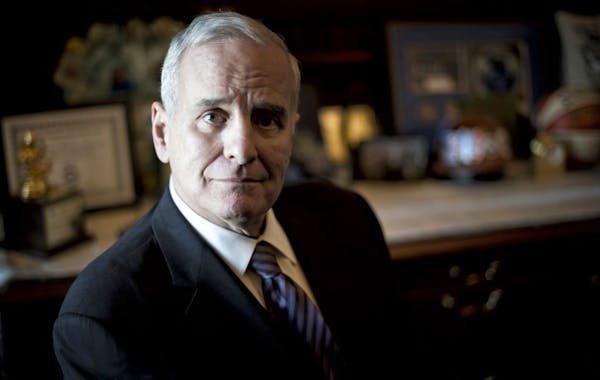Democrats are in charge at the Legislature, but that won't mean friction-free governing.
Already the House and Senate leaders say they are prepared to take on friends, opponents and even the governor, if needed, to prove that a state governed by Democrats can create progress without overreaching.
"We will have disagreements," said incoming Senate Majority Leader Tom Bakk, DFL-Cook. "That's how the system is supposed to function. The governor is not going to get everything he wants, and neither is the Legislature."
But DFLers are keenly aware that voters thrust power upon them at least in part because they had grown weary of partisan bickering and gridlock. Democrats say theirs will be a "productive" friction.
Whatever minor differences emerge, on larger goals the new DFL leaders and DFL governor agree: Taxes will go up on the wealthy; local communities and property taxpayers should get a fairer shake; more Minnesotans will have access to health care and high quality education.
"My hope is when this session is over, that we have shown Minnesotans that we can govern responsibly," said Bakk, who takes over the Senate leadership role after nearly two decades in the Legislature.
They will make that effort while wending through dramatically changed relationships.
Over the past two years, Bakk and incoming House Speaker Paul Thissen, DFL-Minneapolis, had to defer to Gov. Mark Dayton -- he had the power and they lacked the votes to change his will. In 2011, when the governor decided the shutdown must end and adopted a budget solution that Republicans could approve, they had little choice but to accept it.
"I think both Tom and I acknowledged that ultimately, it was his call to make," Thissen said.
Now the governor will need their votes to have his wishes come true. Dayton, currently recovering from back surgery, soon will propose a tax overhaul and a deficit-closing budget. Democrats in the House and Senate may have their own ideas about how to achieve those same goals.
"The Legislature should always have a cautious eye on the governor," said Roger Moe, a DFLer who led the Senate from 1981 to 2001. "There will be tension. It was all designed to be that way."
The new legislative leaders and the governor rose to their positions on separate tracks and barely knew each other before they became rival combatants in the 2010 governor's race. Traipsing across the state from forum to debate and back again led them to respect one another, which proved useful as Dayton took over the governor's office, and Bakk and Thissen slipped into minority leader roles. That intimate knowledge may be even more helpful as the trio steers the Capitol toward what DFLers want.
All DFL, all different
Although they are all Democrats, Dayton, Bakk and Thissen are starkly different in manner and history.
Bakk hails from tiny Cook, a northern spot closer to Canada than St. Paul. His new corner office evokes his northern home -- the shelves and walls house creatures he hunted and fished himself. The base of his coffee table is hewn from a massive pine tree he chopped down.
The tree had been left behind by "environmentalists," he said, who didn't know it would die without protection.
The burly 58-year-old, who served as Senate Taxes chair, has not always been a DFL caucus stalwart.
Stung by a 2003 end-of-session budget deal that snatched state aid from the Iron Range, he quit the caucus, became a political free agent and spoke openly about the need for new leadership.
"I still support the decision I made that night. Leadership sometimes is very lonely and sometimes it is very risky," Bakk said. The next session, under a new majority leader, Bakk rejoined the DFL caucus.
Thissen, a 46-year-old health care policy wonk once picked as one of the Twin Cities' "best brains," is a white shoe Minneapolis attorney with prematurely gray hair and a Harvard and University of Chicago pedigree.
The consummate introvert in an extrovert's job, Thissen admits that if he had spare time, "If I had a choice, I'd ultimately just sit and read."
Asked how he'd shown the strategic skills to go along with his cerebral side, Thissen paused: "I'm a Minnesotan, so those are hard questions." But ultimately, his rise -- from health committee chair to well-funded gubernatorial candidate to minority leader key to helping secure the Vikings stadium, and now speaker -- shows his quiet political ambition meshes with his book smarts.
Murphy rising
Joining Thissen in leadership is independently elected House Majority Leader Erin Murphy, a St. Paul DFLer who was a key operative in the party's takeover of the House.
A nurse by training and former nurses' union staffer, Murphy rose to statewide notice after Republican Gov. Tim Pawlenty's 2010 veto of spending on a health care program for the very poor.
She and GOP Rep. Matt Dean, of Dellwood, banded together to forge a compromise to get the program back on its legs.
"I think she understands the need to get to a point at the end of the day where you complete your work and you move forward," said Dean, who was the Republicans' majority leader over the past two years.
Murphy often will be the public face of the House. As Thissen manages floor action from the speaker's dais, she will be on the floor speaking for the party and managing DFLers.
It's a natural division. Asked how she contrasts with Thissen, Murphy said: "I think I talk more."
Rachel E. Stassen-Berger • Twitter: @rachelsb
Several gun bills inspired by mass shooting are headed for final passage in Maine
The Latest | First 6 jurors in Trump's hush money trial seated, others still needed
Former Michigan House leader and wife charged with misusing political funds

